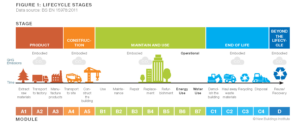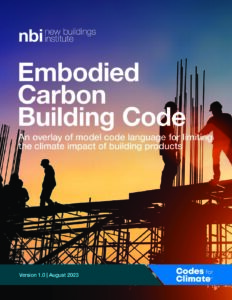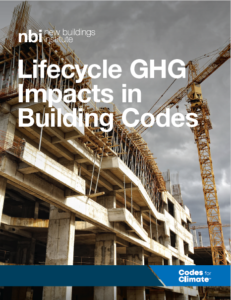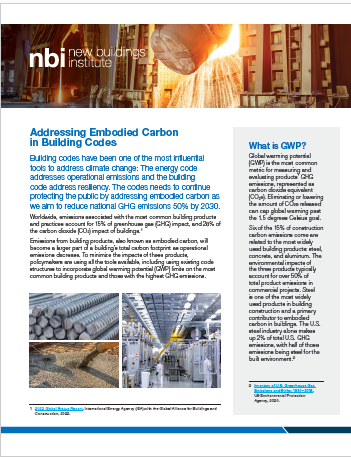Embodied Carbon
 Building operations and construction-related activities are responsible for approximately 39% of humanity‘s global greenhouse gas (GHG) emissions. More than a fourth of those are embodied carbon emissions, those associated with the production of building materials, construction activities, operations, and end of life. In addition, fluorinated gases (F-gas), used to make refrigerants, are responsible for another 2% of all GHG emissions. Embodied emissions are less discernible than operational emissions and have been largely ignored, yet embodied carbon is an equally important emission source causing environmental degradation. Regulators, manufacturers, architects, engineers, and contractors all have a role to play in mitigating the impacts of these emissions.
Building operations and construction-related activities are responsible for approximately 39% of humanity‘s global greenhouse gas (GHG) emissions. More than a fourth of those are embodied carbon emissions, those associated with the production of building materials, construction activities, operations, and end of life. In addition, fluorinated gases (F-gas), used to make refrigerants, are responsible for another 2% of all GHG emissions. Embodied emissions are less discernible than operational emissions and have been largely ignored, yet embodied carbon is an equally important emission source causing environmental degradation. Regulators, manufacturers, architects, engineers, and contractors all have a role to play in mitigating the impacts of these emissions.
Helpful Resources
 Embodied Carbon Building Code Overlay
Embodied Carbon Building Code Overlay
The Embodied Carbon Building Code overlay introduces code solutions incorporating prescriptive embodied carbon International Building Code (IBC) amendments for nearly 40 products, encompassing widely used and high carbon-emitting building materials. The overlay was created for policymakers seeking code language to address GHG emissions in commercial new construction or major renovations.
Access the Report
Lifecycle GHG Impacts in Building Codes

This report gives an overview of embodied carbon emissions impacts and presents language to incorporate embodied carbon requirements in building codes. Researchers explain the need to address the embodied carbon of the highest emitting materials and the carbon emission benefits for jurisdictions. Until the report’s release, there was a lack of understanding of what a regulation on embodied carbon would look like in a U.S. base code. The code acknowledges the importance of building materials in the construction industry and aims to achieve practical reductions in climate impact by selecting lower embodied carbon materials. Example code language can be adopted by jurisdictions starting with EPD reporting to target GWP limits for specific materials, and finally moving to whole building lifecycle analysis.
Access the Report
Addressing Embodied Carbon in Building Codes Fact Sheet
This factsheet shows how the building code can address embodied carbon from buildings as we aim to reduce national GHG emissions 50% by 2030. Building codes have been one of the most influential tools to address climate change: The energy code addresses operational emissions, and the building code address resiliency. The document illustrates cost considerations and the market’s readiness to address both prescriptive and performance-based embodied carbon requirements. Jurisdictions can use existing policies, processes, and fee structures to present, confirm, and enforce these requirements.
Access the Fact Sheet
What is embodied carbon?
Embodied carbon refers to the total impact of all GHG emitted from material extraction through the end of its useful life (Stages A1-A5, B1-B5, and C1-C4). Embodied carbon is calculated by summing all GHG emitted from nonrenewable energy sources resulting from sourcing raw materials, manufacturing, transporting, construction and installation activities, ongoing material/product energy use, maintenance, repair, and finally, disposal. The GHG are presented as carbon dioxide equivalent (CO2e) and synonymous with global warming potential (GWP.) Sub definitions distinguish a specific focus on a product‘s lifecycle stage, as defined by European standard EN 15978, or a unique boundary condition.
To dig deeper, check out:
The Embodied Carbon Conundrum: Solving for All Emission Sources from the Built Environment
 This blog introduces the issue of embodied carbon and why it must be a larger focus within the built environment. Buildings account for 39% of global energy-related carbon emissions worldwide: 28% from operational emissions (from energy needed to heat, cool and power them), and the remaining 11% from materials and construction. Policymakers, designers and builders have been implementing voluntary as well as mandatory strategies aimed at reducing the energy use and carbon emissions associated with building operations by focusing on building envelope, lighting, heating, ventilation, cooling, and equipment. In the future, as carbon emissions from building operations continue to decrease, embodied carbon will account for a larger and larger share of the emissions from new buildings.
This blog introduces the issue of embodied carbon and why it must be a larger focus within the built environment. Buildings account for 39% of global energy-related carbon emissions worldwide: 28% from operational emissions (from energy needed to heat, cool and power them), and the remaining 11% from materials and construction. Policymakers, designers and builders have been implementing voluntary as well as mandatory strategies aimed at reducing the energy use and carbon emissions associated with building operations by focusing on building envelope, lighting, heating, ventilation, cooling, and equipment. In the future, as carbon emissions from building operations continue to decrease, embodied carbon will account for a larger and larger share of the emissions from new buildings.
Jurisdictions Prepare for a Wave of Embodied Carbon Policies
 This blog explores the way that policy can step up to tackle the growing issue of embodied carbon to reduce greenhouse gas (GHG) emissions in the building sector. As more product information has become available about the carbon-intensive footprint of building materials (spanning from raw material extraction through manufacturing), consumer demand for better options is growing. Recognizing the climate emergency, some jurisdictions are aligning their policies to reduce embodied carbon emissions.
This blog explores the way that policy can step up to tackle the growing issue of embodied carbon to reduce greenhouse gas (GHG) emissions in the building sector. As more product information has become available about the carbon-intensive footprint of building materials (spanning from raw material extraction through manufacturing), consumer demand for better options is growing. Recognizing the climate emergency, some jurisdictions are aligning their policies to reduce embodied carbon emissions.
Where is embodied carbon being regulated?
Policy: Procurement policies are a common policy addressing greenhouse gas emissions in individual construction materials. The procurement policy approach incorporates low-carbon construction purchasing requirements for any project receiving jurisdiction funds. Policy components include disclosure (GWP), incentives (bid bonus), and standards (GWP limits.) Low carbon procurement policies can make the largest carbon reduction impact when it comes to new construction. And since jurisdictions are the largest purchasers of concrete, second only to residential construction, concrete procurement policies can make a huge impact.
- Buy Clean California was the first state-wide procurement policy to pass in 2017. The policy sets GWP limits on structural steel, rebar, flat glass, and mineral wool insulation products purchased for state-funded projects. Design teams will be required to identify industry-wide average (or less) embodied carbon emissions for the stated materials, collect supporting environmental product declarations, and verify compliance.
- Portland, Oregon’s Low Carbon Concrete Initiative is a procurement policy that sets concrete GWP thresholds for all City-funded infrastructure and building construction projects.
- Hawaii’s Carbon Dioxide Mineralized Concrete is a procurement policy different from Buy Clean. Instead of setting a GWP limit for a material, the policy requires all state-funded projects that use concrete to include carbon capture.
- Vancouver’s Green Buildings Policy for Rezoning requires all rezoning projects to conduct a whole building lifecycle analysis study and report the embodied carbon GWP to the City.
Code: Climate advocates have long been focused on the energy code as the only solution to solving climate change—asking that code alone to shoulder the responsibility for all things energy, carbon, and climate-related. However, because the scope of the energy code is intended to address the way the building operations use energy, NBI has proposed that embodied carbon is addressed where other materials are regulated within code, the building code, over the energy code.
- Marin County Low Carbon Concrete Code was the first code (2020) that required all new commercial building projects to incorporate low-embodied carbon concrete. The code allows two approaches: a prescriptive GWP limit per concrete strength or a performance cement GWP limit regardless of concrete strength.
- Denver, Colorado is currently exploring code amendments for their base codes and stretch codes which require concrete, reinforcing bar, structural steel environmental product declaration (EPD) reporting, and GWP limits.
Other resources
NBI Webinar: Solving for the 11% embodied carbon footprint in the built environment
As clean energy policy and practice ratchet down operational carbon emissions in the built environment, embodied carbon becomes a larger share of buildings’ carbon footprint. In this webinar, participants will learn about primary sources of carbon embedded in manufacturing processes and approaches on low-carbon material selection, including cost analysis that shows how even deep energy and carbon retrofits can make financial sense. In addition, presenters use case studies to share a method using lifecycle carbon as a means to intertwine embodied and operational carbon into a cumulative timeline.
Watch On-Demand
Getting to Zero Embodied Carbon Resource Hub
This curated list of resources includes embodied carbon and life cycle analysis resources, including methodology and tools, policies and codes, and project case studies, to support low carbon construction materials. Introductory guides explain the basics of calculating carbon throughout the life cycle of a building; calculators and web-tools will highlight material carbon intensities, and other references will suggest how materials should be specified.
Access Resource HubFor questions, please email NBI Associate Director of Codes and Policy, Webly Bowles.
